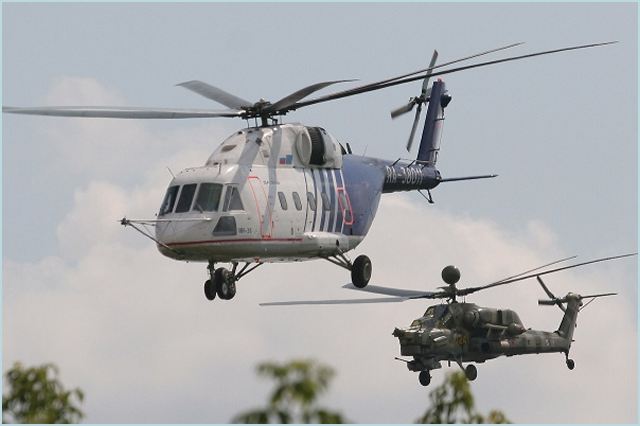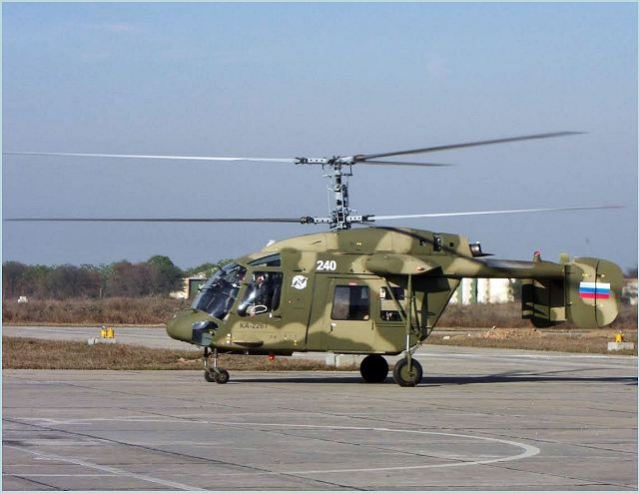Breaking news
Russian Helicopters day to open at International Aviation Salon MAKS 2011.
 |
|||
Online
Show Daily News MAKS 2011 International Aviation and Space Salon Moscow Zhukovsky Air Base, Russia 16 - 21 August 2011 |
|||
Press
release Russian helicopters at MAKS 2011 |
|||
| Russian Helicopters day to open at International Aviation Salon MAKS 2011 | |||
Moscow/12
August 2011 – 16 August, the first day of the milestone 10th International
Aviation and Space Salon MAKS 2011, will be marked as Russian Helicopters
Day, dedicated to the Russian rotorcraft industry corporation that is
a subsidiary of the United Industrial Corporation Oboronprom. Airshow
visitors will see modern light Mi-34C1, Ka-226T, and Ansat, medium Ka-32A11BC,
the new modernised ultra-heavy Mi-26T2, and the attack Ka-52 Alligator,
Mi-28NE Night Hunter, and other rotorcraft at the static display and in
the sky above the exposition. |
|||
 Mi-38 transport helicopter Russian aviation defence industry |
|||
A joint Russian
Helicopters and UIC Oboronprom press-conference will be held at 11:00
a.m. in Conference Hall C3 on this day. New projects will be discussed
and contracts announced. Pavilion C3 will also house business events,
while the airfield will become the stage for a civil and military helicopter
airshow. |
|||
 KA-226T transport helicopter Russian aviation defence industry |
|||
The
helicopter, created to develop medical aviation in Russia, is equipped
with two Turbomeca Arrius 2G turboshafts and the Russian VR-226N reductor.
This is the first time the French Arrius 2G engines were installed on
a coaxial-rotor machine. The Ka-226T is a unique example of successful
international cooperation, offering customers a wide variety of possibilities
in terms of manoeuvrability, rate of climb, and ceiling. Such technical
solutions make the Ka-226T extremely safe: it possesses up to 750 hp even
with one engine out, leaving it with enough power to manoeuvre. Two prototypes of the new passenger and cargo Mi-38 will be showcased at MAKS. OP-1 with TV7-117V engines and OP-2 with Pratt & Whitney engines will be displayed to visitors and experts at the airshow both on static and in flight. The Mi-38 is a next-generation rotorcraft offering highest modern levels of safety and comfort in its class. Certification is scheduled for 2014. The experimental Mi-26T2 will be among the innovations presented at the Russian Helicopters exposition. It is currently continuing test flights. The helicopter is fitted with a modern BREO-26 avionics suite designed by Ramenskoye Design Company. The glass cockpit of the Mi-26T2 is equipped with five multi-functional LCDs that can display a coloured image of external load, a new digital autopilot and a new navigation system supporting NAVSTAR/GLONASS. The helicopter is also fitted with an additional Tranzas TSL-1600 light to visually control external load at night. It is capable both of standard and IR lighting to be used in combination with night vision goggles. Apart from this, modernised D-136-2 engines are intended for this machine. They are a step forward from the D-136 in their use of FADEC, an emergency power output of 12500 hp available at temperatures up to +30º?, and takeoff power that has been increased by 250 hp at maximum takeoff mode. The new avionics allow the operation of this helicopter in any point on the planet and let it perform flights to international IFR standards. Modern equipment has brought down the total crew headcount to 2 from 5, adding an operator to work with the external sling if necessary. The remaining cabin space has been given to people accompanying load. Qualitative changes have come about in the Russian rotorcraft industry since the participation of Russian Helicopters in MAKS 2009. The holding company has consolidated the entire industry and made a leap forward in its development. Today at MAKS 2011 the Russian helicopter industry will be represented by a sole consolidated structure. The holding company is open for cooperation with rotorcraft operators and ready to establish beneficial partnership at all stages of the helicopter lifecycle, from design to aftersale service. |
|||


























